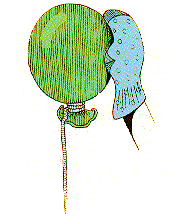HAIR-RAISING RESULTS
Have you ever been shocked when you walked across a rug or touched a light switch? Wait until a cool, dry day to learn about static electricity.
 What you'll need
What you'll need
A cool, dry day
2 round balloons (inflated and tied)
2 20-inch pieces of string
1 wool or acrylic sock.
1 mirror (or more)
1 friend (or more)
Your science journal
What to do
- Tie a string to each inflated balloon.
- Rub a balloon on your hair for about 15 seconds. Be sure to rub around the whole balloon. What happens to your hair? What happens when you bring the balloon back close to your hair?
- Rub the balloon on your hair again and have a friend (or parent) do the same with the other balloon.
- Each of you hold the string to 1 balloon, letting the balloons hang freely, but without letting them touch anything.
- Slowly move the 2 balloons toward each other, but don't let them touch. What do you see? Do the balloons push away from each other, or do they pull toward each other?
- Place your hand between the two hanging balloons. What happens?
- Place a sock over 1 hand and rub 1 balloon with the sock. Then let the balloon hang freely. Bring your sock-covered hand near the balloon. What happens?
- Try rubbing both balloons with the sock and then let them hang near each other. What happens?
- Look for other examples of static electricity around the house. Have you ever felt a shock when you touched a metal doorknob on a cold winter day? What often happens when you remove the clothes from the dryer?
All materials contain millions of tiny particles, called protons and electrons, that have electric charges. Protons have positive charges, and electrons negative ones. Usually, they balance each other, but sometimes when two surfaces rub together, some of the electrons rub off one surface onto the other and we can have static electricity. Materials with like charges (all positive or all negative) move away from each other; those with opposite charges attract each other.
MOLDY OLDIES
Molds are tiny microscopic plants that can help or hurt us. Molds like some environmental conditions better than others. Find out which ones they prefer by watching mold grow.
What you'll need
Grown-up alert!
3 cups containing a little coffee or leftover food.
Your magnifying glass.
Your science journal.
What to do
- Put 1 cup with coffee or leftover food on a sunny windowsill, 1 in the refrigerator, and 1 in a dark cupboard. Look inside the cups every day for several days and write down what you see. Your magnifying glass will help. (It may take a few days for the mold to start growing.)
- Does temperature affect the mold's growth? See if the cup left on the windowsill grows mold ... more slowly, more quickly, or at the same rate as the one in the refrigerator.
- Does light affect the growth of the mold? Does the cup on the windowsill grow mold at the same rate as the one in a dark cupboard?
- Look around your home for other molds. Inspect:
Pickles in a jar
Cottage cheese
Bread
Paint on the walls
Oranges
House plants
Tiles around the bathtub or shower.
- Are the molds all the same color, or are they different?
We can find molds in all sorts of unexpected places. Unlike green plants, they can't make their own food from sunlight. Instead, they live directly off of what they are growing on.
Molds can be a nuisance when they settle on our food or possessions. But molds are also useful. The green spots on old oranges are penicillin mold. This is what the medicine is made from.